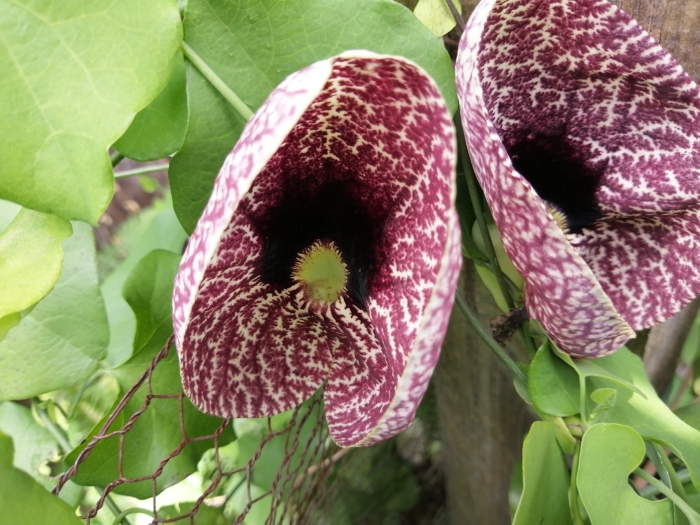Calico Flower
(Aristolochia elegans)
Calico Flower (Aristolochia elegans)
/
/

© Jorge Armín Escalante-Pasos
CC BY 4.0
Image By:
© Jorge Armín Escalante-Pasos
Recorded By:
Copyright:
CC BY 4.0
Copyright Notice:
Photo by: © Jorge Armín Escalante-Pasos | License Type: CC BY 4.0 | License URL: http://creativecommons.org/licenses/by/4.0/ | Uploader: escalante-pasos | Publisher: iNaturalist |



































Estimated Native Range
Summary
Aristolochia elegans, commonly known as Calico Flower or Elegant Dutchman’s Pipe, is an evergreen climbing vine native to Brazil and also found in other parts of South America. It thrives in tropical and subtropical forests, often in clearings or at the forest edge where it can receive dappled sunlight. This vine can reach lengths of 3–4.5 meters (9.8–14.8 ft) and has slender woody stems with bright green, heart-shaped leaves. The flowers are distinctive and ornamental, heart-shaped, greenish-yellow with intricate purplish-brown markings, resembling Sherlock Holmes’s pipe. They are about 7–8 centimeters (2.8–3.1 in) long and grow solitary in the leaf axils. The inner surface of the flared mouth is completely purplish-brown, and the flowers emit a carrion-like odor to attract pollinating flies. Flowering occurs throughout the summer and is quite showy due to the unique shape and patterning of the blooms.
The Calico Flower is valued for its unusual flowers and is often used in tropical and subtropical gardens as an ornamental vine on trellises, arbors, and fences. It can also be grown in conservatories in temperate regions. The plant prefers acid-neutral soils (pH 5.5 – 7.0) with average moisture and can tolerate a range of light conditions from part sun to shade. While it is frost-sensitive, requiring a minimum temperature of 7 °C, it can be grown under glass in cooler climates. It has earned the Royal Horticultural Society’s Award of Garden Merit, indicating its value in cultivation. Care should be taken, as all parts of the plant contain toxic compounds that can be harmful if ingested.CC BY-SA 4.0
The Calico Flower is valued for its unusual flowers and is often used in tropical and subtropical gardens as an ornamental vine on trellises, arbors, and fences. It can also be grown in conservatories in temperate regions. The plant prefers acid-neutral soils (pH 5.5 – 7.0) with average moisture and can tolerate a range of light conditions from part sun to shade. While it is frost-sensitive, requiring a minimum temperature of 7 °C, it can be grown under glass in cooler climates. It has earned the Royal Horticultural Society’s Award of Garden Merit, indicating its value in cultivation. Care should be taken, as all parts of the plant contain toxic compounds that can be harmful if ingested.CC BY-SA 4.0
Plant Description
- Plant Type: Vine
- Height: 8-20 feet
- Width: 3-6 feet
- Growth Rate: Moderate
- Flower Color: Purple, Red, White
- Flowering Season: Summer, Fall
- Leaf Retention: Evergreen
Growth Requirements
- Sun: Full Sun, Part Shade
- Water: Medium
- Drainage: Medium, Fast
Common Uses
Bee Garden, Bird Garden, Butterfly Garden, Fragrant, Hummingbird Garden, Low Maintenance, Showy Flowers
Natural Habitat
Native to Brazil and other parts of South America, often found in tropical and subtropical forests
Other Names
Common Names: Calico-Flower, Elegant Dutchman’s Pipe, Strand-Pfeifenwinde, Patito, Cipó-De-Cobra, Jarrinha, Milhomes, Papo-De-Peru, Calico Flower, Duck Vine
Scientific Names: , Aristolochia littoralis, Aristolochia elegans, Aristolochia hassleriana, Aristolochia elegans var. hassleriana,
GBIF Accepted Name: Aristolochia elegans Mast.